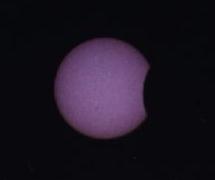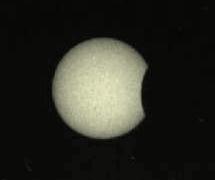|
A sequence of the partial eclipse is shown in the image below.
First Contact is when
the moon just starts to cover the sun, the partial phase continues until
Second Contact
which when the total eclipse starts. The partial phase starts again at
Third Contact until the Fourth Contact when
the sun is no longer covered at all.
Even though a significant part of the sun may be covered during the partial phase, any darkening is not particularly noticeable until well over 90% of the sun is hidden from view. This is due to the way the human eye naturally adapts to a wide range of different lighting levels and the gradual covering of the sun is slow enough for the eye to adapt without any noticeable change. NOTE: During the partial phases it is not safe to view the eclipse whatsoever without the use of protective filters. |
The images were taken using a 300mm lens using an ND5 BAADER filter. This gives
a 10^5 reduction in light intensity, the ND stands for Neutral Density with
theoretically should pass all wavelengths of light equally.
The exposure times were 1/125th second at f/16 using 100 ASA film. In other words the use of the filter gives fairly normal exposure settings. Only the initial partial phase was photographed, the part between First Contact and Second Contact. |
|||
 |
||||
| ||||
 |
This is what the partial phase between Third Contact and Fourth Contact may have looked like. This image is actually a cheat and is a mirror image of the original sequence :o) | |||

